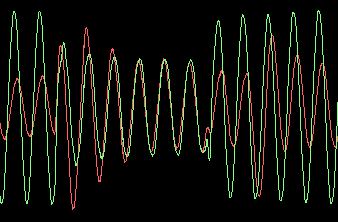|
Below is a superb example of a phase-to-phase short between the supply and a site, metered at the input to the site. Being a packing plant it had mainly motors driving all the processes resulting in a rather noticable lag on the current.
Then came the short. This happened between phase B & C (B is shown in the snapshot). There is one extremely tell-tale sign of what happened being the voltage curve suddenly shifted towards the lag (dragged towards C which lags behind B). What also tells a huge story is how the current reacts over the next few cycles, and how it confirms the fault was external to the site. Notice how the current was suddenly leading the voltage at the point of the fault. Within a half cycle the current rose approximately 3 times in value, and then over the next two cycles dropped as well as changed phase angle as the motors re-adjusted to their new input. The fault lasted for 5½ cycles. Suddenly the motors were now lagging behind the input (the current drops significantly). Two cycles later, however, these motors have slowed down. Suddenly there is a significant rise in current as the motors are brought up to speed and their phase angle aligned with the input again. There would have decidedly been a mechanical "shock-wave" through the plant as a result of this electrical fault, one that could have easily tipped bottles over etc. Tell-tale points that clearly indicate this was external to the site was that the current did not inversely follow the voltage (current up while voltage falls). It load 'reacted' to the incoming voltage. The current fell during the fault condition and rose after the fault cleared. Semi complex recorders may not have given a user such a detailed picture - as is this finding was used in a legal case. The above was captured using a Reliable Power Meters' Power Recorder. | | Ask a Question | © 05.09.01 |
 INTERPRETING THE READINGS:
INTERPRETING THE READINGS: